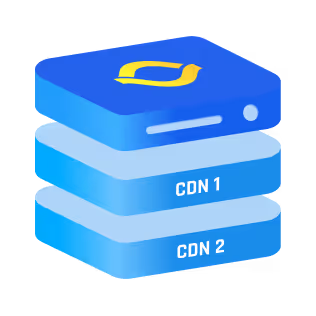What are the Factors that Influence DNS Propagation Time?
Table of contents
DNS propagation time depends on TTL settings, ISP caching, DNS server updates, and geographic distribution. If you've just updated a DNS record, it can take anywhere from a few minutes to 48 hours for the changes to reflect worldwide.
You can check the status using a DNS propagation checker and speed it up by lowering TTL before changes and clearing caches.
That said, here’s how these factors affect the big picture:
1. TTL (Time-To-Live) Settings
TTL (Time-To-Live) is a numerical value assigned to each DNS record that tells recursive resolvers (like your ISP’s DNS server) how long they should store (cache) the DNS response before asking the authoritative DNS server for an update.
Every time a user tries to visit a website, their DNS resolver checks its cache first. If the record is still "alive" within the TTL duration, it serves the cached response instead of fetching new data from the authoritative DNS server. This is often the primary bottleneck.
How TTL Impacts DNS Propagation
- High TTL (e.g., 86400 seconds / 24 hours) → Cached records last a full day, meaning changes take longer to propagate.
- Low TTL (e.g., 300 seconds / 5 minutes) → Cached records expire quickly, meaning faster updates but more DNS queries to authoritative servers.
If a DNS record has a TTL of 24 hours, it means all resolvers and caching servers worldwide won’t check for updates until the TTL expires. That’s why setting a high TTL before a DNS change can delay propagation for a full day.
How to Speed It Up?
- Plan ahead – If you’re going to update a DNS record, lower the TTL at least 24 hours before making changes.
- Example: If your current TTL is 86400 seconds (24 hours), lower it to 300 seconds (5 minutes) a day before updating.
- After making the change, keep TTL low for a few hours or until you confirm full propagation.
- Once propagated, increase TTL back to a higher value (e.g., 1 hour or more) to reduce load on your DNS servers.
Why Not Keep TTL Always Low?
- Higher TTL reduces DNS query volume, preventing unnecessary load on your authoritative DNS servers.
- Some DNS providers enforce a minimum TTL policy, meaning you might not be able to set it below a certain threshold (e.g., 30 minutes).
2. ISP Caching Policies
Even if you’ve set a low TTL, your ISP may ignore it.
Internet Service Providers cache DNS records separately from authoritative and recursive resolvers. Some ISPs follow TTL settings strictly, while others override them with fixed refresh intervals (e.g., every 24 hours). These are often the most uncontrollable factor when optimizing propagation time.
Why Do ISPs Cache DNS?
- Reduce DNS query volume – Constantly querying authoritative DNS servers increases bandwidth usage.
- Improve browsing speed – Cached records mean faster responses for users.
- Reduce load on ISP infrastructure – ISPs prefer to refresh DNS data in bulk instead of querying every TTL expiration.
How to Speed It Up?
- Use a different DNS resolver – Switching to Google Public DNS (8.8.8.8) or Cloudflare DNS (1.1.1.1) bypasses your ISP’s caching rules.
- Manually flush your ISP’s DNS cache (where possible) – Some ISPs provide tools to clear cached DNS records.
- Test different networks – If your DNS change isn’t reflecting, try using mobile data, a VPN, or another Wi-Fi network.
3. Geographic Location & DNS Server Distribution
- DNS is hierarchical and distributed – It consists of root servers, TLD servers, authoritative servers, and recursive resolvers.
- Different regions have different refresh intervals – Some countries/regions have slow DNS updates due to network policies or government-controlled infrastructure.
Example:
- Google and Cloudflare DNS update within minutes
- Small ISPs and regional DNS servers may take hours
If you’re based in Europe and update a DNS record, it might reflect quickly in North America but take longer in Asia or Africa.
How to Speed It Up?
- Use a DNS propagation test tool to check global updates:
4. Registrar and DNS Provider Speed
Not All DNS Providers Update at the Same Speed
Your domain registrar or DNS hosting provider plays a significant role in how quickly records update. Some DNS providers sync changes instantly, while others have internal delays in their systems.
Fastest DNS Providers (Near-Instant Updates)
- Cloudflare DNS
- Google Cloud DNS
- AWS Route 53
- OpenDNS
Slower DNS Providers (May Take Hours)
- GoDaddy
- Namecheap
- Bluehost
How to Speed It Up?
- If your DNS provider has slow propagation times, consider switching to a faster DNS service.
- Some registrars take time to process DNS record changes internally before pushing them live. If your updates are delayed, check if the issue is on their end.
5. Local Device and Browser Caching
Even after DNS propagation is complete, you might still see old records due to caching on:
- Your operating system (OS) cache
- Your browser’s DNS cache
- Your router’s cached records
How to Speed It Up?
Flush Your Local DNS Cache:
- Windows:
- ipconfig /flushdns
- Mac:
- sudo killall -HUP mDNSResponder
- Linux:
- systemctl restart systemd-resolved
Clear Browser Cache:
- Chrome:
- Open chrome://net-internals/#dns
- Click Clear host cache
- Firefox:
- Go to Settings → Privacy & Security
- Click Clear Data
Restart Your Router: Some routers cache DNS responses for performance reasons. A simple restart can force it to fetch updated DNS records.
Why Does DNS Propagation Take Up to 48 Hours?
Even after following all the best practices, DNS propagation worldwide can still take up to 48 hours.
Why?
- Some ISPs override TTL values and update DNS records only once per day.
- Some DNS servers update slower than others due to regional differences.
- Some networks use private caching policies that delay updates.
Most changes, however, propagate within a few minutes to a few hours if you use a fast DNS provider and low TTL values.


